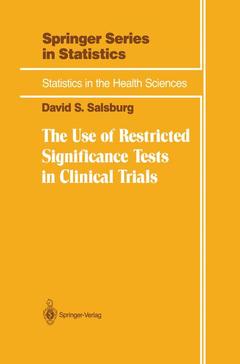The Use of Restricted Significance Tests in Clinical Trials, Softcover reprint of the original 1st ed. 1992 Statistics for Biology and Health Series
Langue : Anglais
Auteur : Salsburg David S.

The reader will soon find that this is more than a "how-to-do-it" book. It describes a philosophical approach to the use of statistics in the analysis of clinical trials. I have come gradually to the position described here, but I have not come that way alone. This approach is heavily influenced by my reading the papers of R.A. Fisher, F.S. Anscombe, F. Mosteller, and J. Neyman. But the most important influences have been those of my medical colleagues, who had important real-life medical questions that needed to be answered. Statistical methods depend on abstract mathematical theorems and often complicated algorithms on the computer. But these are only a means to an end, because in the end the statistical techniques we apply to clinical studies have to provide useful answers. When I was studying martingales and symbolic logic in graduate school, my wife, Fran, had to be left out of the intellectual excitement. But, as she looked on, she kept asking me how is this knowledge useful. That question, what can you do with this? haunted my studies. When I began working in bio statistics, she continued asking me where it was all going, and I had to explain what I was doing in terms of the practical problems that were being ad dressed.
One Philosophical and Scientific Problems when Applying Statistical Methods to Clinical Data.- 1 The Randomized Controlled Clinical Trial.- 1.1. RCTs as Scientific Experiments.- 1.2. Statistical Considerations.- 1.3. The Overall Plan of This Book.- 1.3.1. Foundations.- 1.3.2. Mathematical Models.- 1.3.3. The Tools of Analysis.- 2 Probability Models and Clinical Medicine.- 2.1. What Is Probability?.- 2.2. The First Use of Significance Tests by Pearson.- 2.3. Fisher’s Contribution.- 2.4. The Neyman-Pearson Formulation.- 3 Significance Tests Versus Hypothesis Tests.- 3.1. Fisher’s Views of the Neyman-Pearson Formulation.- 3.2. Problems with the Frequentist Definition of Probability.- 3.3. Significance Testing Versus Hypothesis Testing.- 3.4. Philosophical Problems.- 3.4.1. Salvaging Neyman’s Insights.- 4 Neyman’s Insights.- 4.1. Restricted Tests.- 4.2. Confidence Intervals.- 4.3. The Meaning of Probability, Again.- 5 Reconciling Fisher and Neyman.- 5.1. What Has Been Developed So Far.- 5.2. The RCT as an Experiment in Medical Science.- 5.3. Probability as a Measure of Belief.- Two Techniques for Applying Restricted Tests to Data from Randomized Controlled Clinical Trials.- 6 Continuous Measures Taken over Time.- 6.1. An Example.- 6.2. Restricted Tests Based on Observations over Time.- 6.2.1. General Methodology.- 6.2.2. Acute Response over Time: Bronchodilator Example.- 6.2.3. A Single Measure for Change over Time.- 6.2.4. Summing Up.- 7 Combining Data Across Measures.- 7.1. An Example.- 7.2. Reducing Many Measures to a Few.- 7.2.1. General Methodology.- 7.2.2. Combining Measures in the Same Scale.- 7.2.3. Combining Measures with Different Scales.- 7.3. Treating Many Measures as a Vector.- 7.3.1. General Principles.- 7.3.2. The Multivariate Normal Distribution.- 7.3.3. Nonparametric Multivariate Methods.- 7.3.3.1. Nearest Neighbor Tests.- 7.3.3.2. Projection Tests.- 8 Counts of Events.- 8.1. An Example.- 8.2. The Advantages of Blocking.- 8.3. Methods for Classifying Patients in Blocks.- 8.4. Trend Tests.- 8.5. Weighted Categories.- 9 Permutation Tests and Resampling Techniques.- 9.1. Permutation Tests.- 9.2. Resampling.- 9.2.1. General Comments.- 9.2.2. The Jackknife.- 9.2.3. The Bootstrap.- 9.3. Afterthoughts.- 10 Neyman’s Restricted Chi Square Tests.- 10.1. Introduction.- 10.2. Constructing a Restricted Test.- 10.3. Restricted Chi Square Tests.- 10.4. An Example.- 11 Miscellaneous Methods for Increasing Power.- 11.1. General Principles.- 11.2. Normal Theory Tests.- 11.2.1. Heterogeneity of Variance.- 11.2.2. Transformations of the Data.- 11.2.3. Alternative Estimates of Variance.- 11.3. Nonparametric Tests.- 11.3.1. General Principles.- 11.3.2. Testing for Heterogeneity of Variance.- 11.3.3. Hajek Type Tests.- 11.3.4. Generalized Thompson Tests.- 12 Bayesian Estimation.- 12.1. A Litde Probability Theory.- 12.2. The Arguments for Bayesian Analysis.- 12.3. Neyman’s Bayesian Derivation of Confidence Intervals.- 12.4. What Can Be Calculated and What Cannot?.- 12.4.1. The Mean of a Normal Distribution.- 12.4.2. The Probability of a Binomial Distribution.- 12.5. Empirical Bayes Procedures.- 12.6. The Role of Bayesian Methods in Clinical Research.- 13 An Example of the Type of Analysis Suggested in This Book.- 13.1. The Study.- 13.2. The Expected Results.- 13.3. Constructing an Overall Powerful Significance Test.- 13.4. Dropouts.- 13.5. The One Overall Significance Test.- 13.6. Alternative Methods of Analysis.- 13.6.1. Blocking on Baseline Characteristics to Get More Homogeneous Blocks.- 13.6.2. Analysis of Maximum and Dominant Symptom.- 13.7. Life Beyond Significance.- 13.7.1. Interval Estimates of the Mean.- 13.7.2. Medically Meaningful Interval Estimates.- 13.7.3. Interval Estimates Based on Nonparametric Tests.- 13.8. Further Exploration.- References.
Date de parution : 12-2011
Ouvrage de 174 p.
15.5x23.5 cm
Disponible chez l'éditeur (délai d'approvisionnement : 15 jours).
Prix indicatif 52,74 €
Ajouter au panierMots-clés :
Master Patient Index; Radiologieinformationssystem; Resampling; methodology; statistics
© 2024 LAVOISIER S.A.S.



